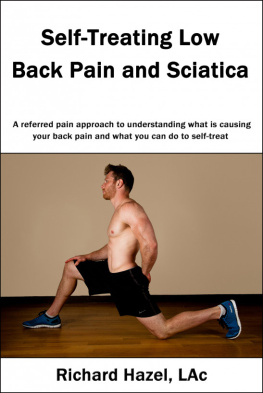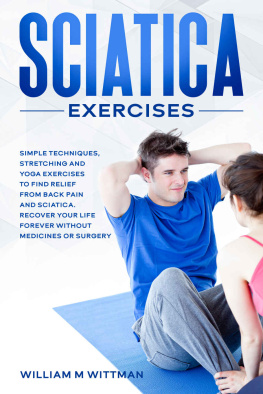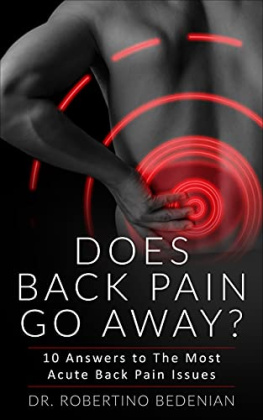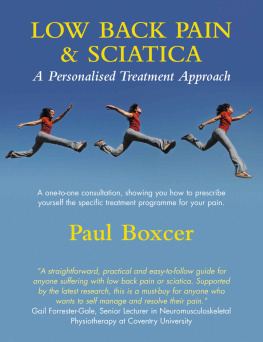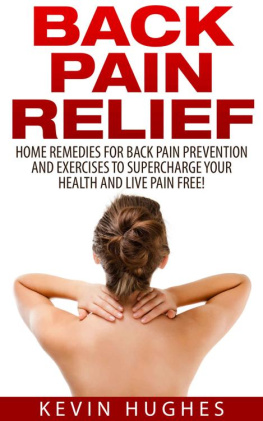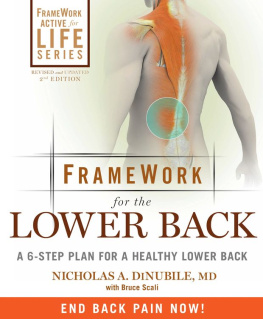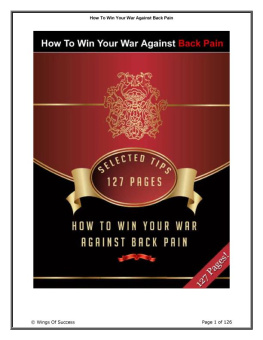Self-Treating Low Back Pain andSciatica
A referred pain approach tounderstanding what is causing your back pain and what you can do toself-treat.
Copyright 2014 Richard Hazel, LAc
Published by Richard Hazel, LAc atSmashwords
Smashwords Edition LicenseNotes
This ebook is licensed for your personalenjoyment only. This ebook may not be re-sold or given away toother people. If you would like to share this book with anotherperson, please purchase an additional copy for each recipient. Ifyoure reading this book and did not purchase it, or it was notpurchased for your enjoyment only, then please return toSmashwords.com or your favorite retailer and purchase your owncopy. Thank you for respecting the hard work of thisauthor.
Legal Disclaimer
This book is for general informationalpurposes only and does not constitute the practice of medicine,nursing or other professional health care services, including thegiving of medical advice, and no doctor/patient relationship isformed. The content of this book is not intended to be a substitutefor professional medical advice, diagnosis, or treatment.. The useof information in this book or materials linked from this book isat the users own risk. Readers should not disregard, or delay inobtaining medical advice for any medical condition they may have,and should seek the assistance of their health care professionalsfor any such conditions and before beginning anytreatment.
Table of Contents
Foreword
Why does an acupuncturist write a bookabout self-treating back pain instead of suggesting seeing anacupuncturist?
I wanted to write a book for myfriends, family and my patients and for anyone who suffers from lowback pain or radiating leg pain but maybe doesnt have access to anacupuncturist.
Too many people suffer from low backand sciatic pain that can be relieved or managed with stretching,foam rollers and a lacrosse ball (even if theyve got MRIs showingdisc bulges or herniation). They just need to know what muscles aregiving them pain so they know how to treat them. You can havespinal irregularities and still have pain from tight or shortenedmuscles!
If this book reaches one person whocan get relief and avoid taking addictive opioid medications itwill be worth all the effort!
Back pain seems to baffle a lot ofdoctors.
Referred pain makes this all verycomplicated. (Referred pain is when it hurts in a place that is notthe source of the problem.)
Thanks to some brilliantdoctors (Drs. Travell and Simons) we dont have to reinvent thewheel. Many of the referred pain patterns in this book arefrom Myofascial Pain and Dysfunction TheTrigger Point Manual, The Lower Extremities . I spent a lot of money on their 2 big volumes and read themback to front so that you don't have to. You can just read thisshort book and get years of information condensed and explainedquickly.
I can't possibly cover all forms ofback pain so I selected the ones that are most common and that havea self-treatment option. There are obviously types of back painwhich will require intervention by your medicalprofessionals.
Fortunately, most of us fall into thecategory of "self-treatable" and not needing surgery!
So take a good look at all the photoson the next pages and select the one or two that most look likeyour pain. Then read that chapter and see if my description soundsright.
Its very common for people to havemore than one of these. The psoas/gluteus medius combo orpsoas/piriformis combo are very common.
I sincerely hope this helps you tofind your way toward being pain-free!
PSOAS
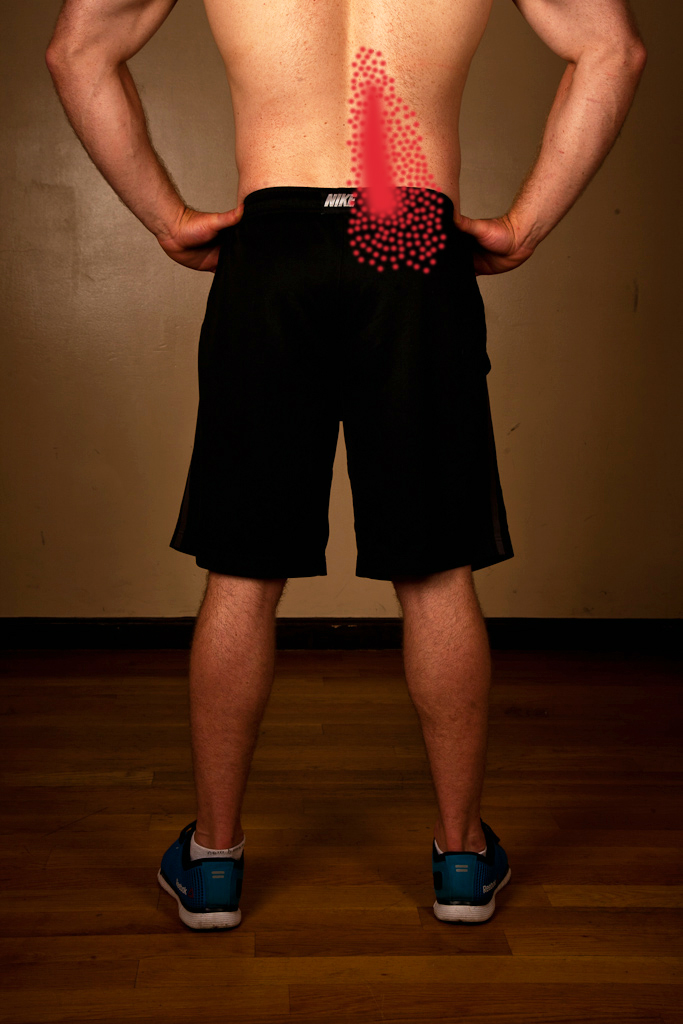
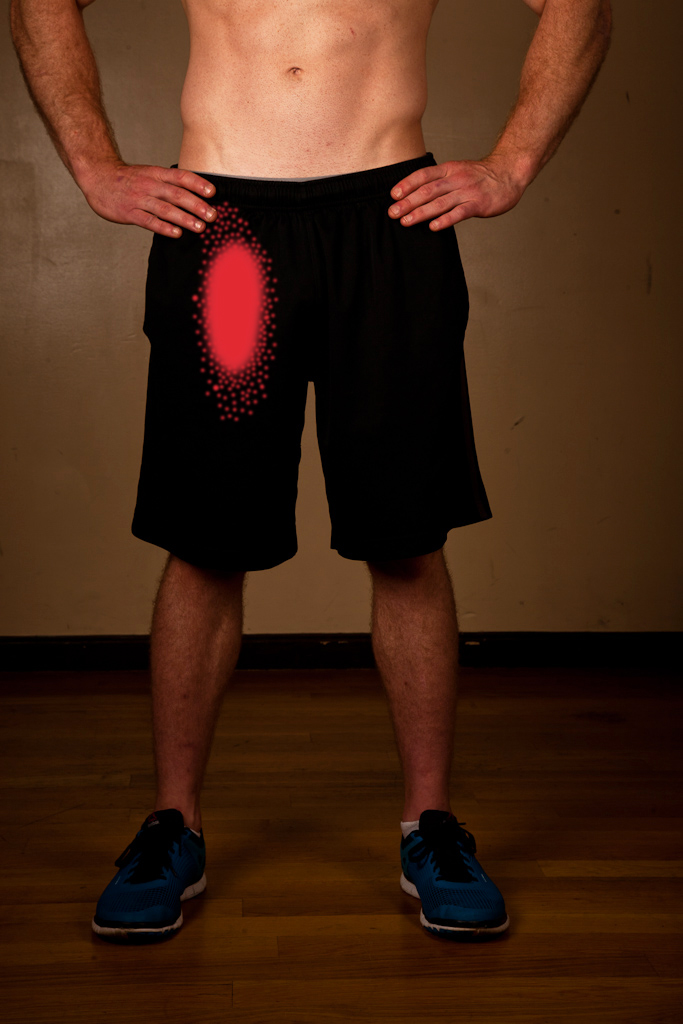
If youve ever had low back pain thatis worse when you first stand up after sitting for a long time andthen it gets better as you walk around, you probably have a tightpsoas. Other signs would be worse pain when lying flat on your backthat is somewhat relieved by sleeping on your side in a fetalposition.
This pain can be crippling when thepsoas is very tight. It can be very painful just to try to walk ashort distance and anti-inflammatory meds dont do much to relievethe pain. The problem is not inflammation; it is muscle shorteningand the resulting tension. Tension on the lumbar spine!
A tight psoas causes lumbar pain andincreased lordosis (arch) in the low back. It will make you feellike you are walking like a duck with your butt sticking back untilyou can walk around a while and warm the muscles up.
You might be asking, How can tighthip flexors make my low back hurt?
Im so glad you asked!
To understand this we have to look atthe origin and insertion of the psoas. Its origin is on thevertebral bodies of from T12 to L5 and that includes theintervertebral disks. The psoas travels down to the iliac fossa ofthe pelvis where it interdigitates with the iliacus (which is whythe muscle is often called the iliopsoas) before attaching to thelesser trochanter of the femur. In plain English: the psoas isattached on the front side of the lower spine, goes to the front ofthe pelvis and down to where it attaches on the inside of the headof the femur (thigh bone).
Since the psoas attaches on the insideof the femur some people will have pain on the front of their legand sometimes they will have groin pain.
The psoas is the strongest hip flexoron the body and it stays in a shortened/flexed position when wesit. So its not hard to imagine how people who sit all day at workthen sit in their car and then sit on their sofa at night for a fewhours are good candidates for some psoas shortening.
When the psoas is tight and causinglow back pain, no amount of heat pads on the low back are going tofix the problem.
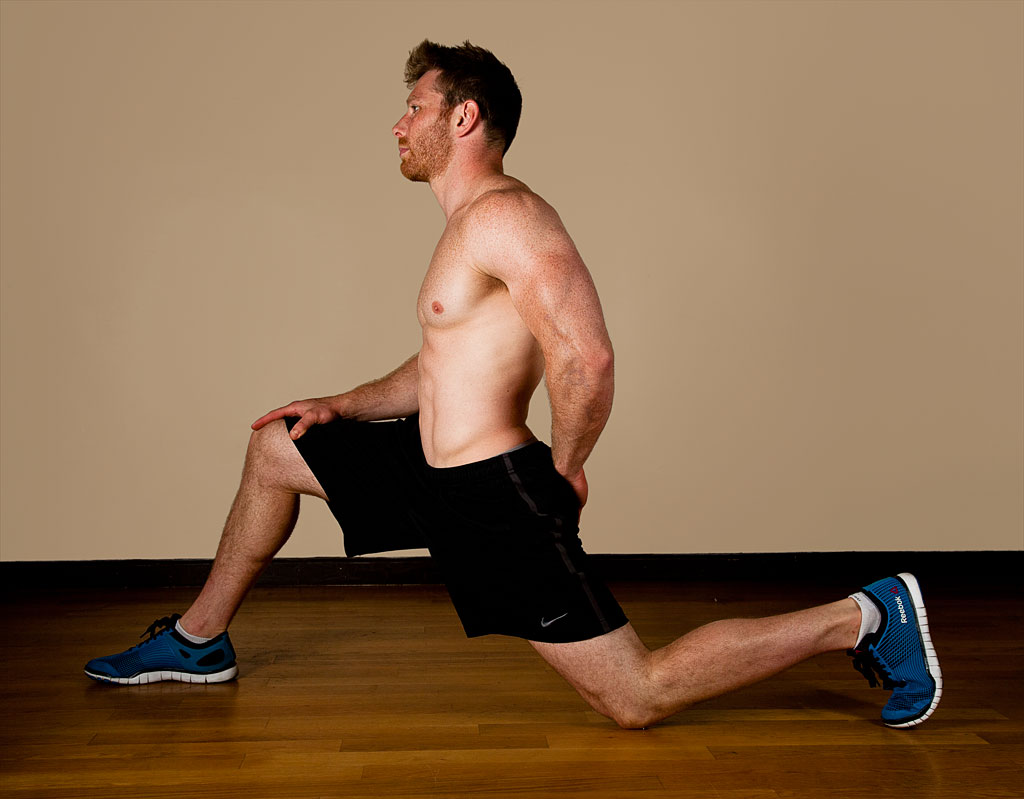
Heres what you need to know toself-treat:
The psoas stretch is done with oneknee on the floor (I suggest kneeling on something soft like carpetor a mat). The side you are going to stretch is the one with theknee on the floor. The other knee is up and that foot is flat onthe floor in front sort of like a lunge position. The key tostretching the psoas here is to keep your torso upright. If youlean your body forward, you are only stretching your quad. If youcan put your hands on your hips and look straight forward that willhelp. Think of leading with your pelvis. You will slowly stretch sothat the kneeling side is being stretched. You may have to inchyour front foot forward on the floor to get the rightposition.
I like to do the psoas stretch using aPNF (proprioceptive neurofunctional) stretching technique where youget to the point where you begin to feel the stretch and then stopand push the knee thats on the floor down and forward to engagethe side you are stretching. You are not exerting yourself; justengaging the muscle. Gentle is the key. Hold for 10 seconds andthen relax your muscle and take a deep breath and try to get alittle more of a stretch out of the psoas by moving your footthats in front forward a little and keep your torso upright. Youcan do this a few times and will probably be surprised how muchmore of a stretch you can get without added exertion.
If you do this stretch a couple timesa day (even more if you can) you should be able to relieve yourpain pretty fast. Maybe youll feel some improvement on the sameday depending on how chronic the muscle shortening is.
Next page
